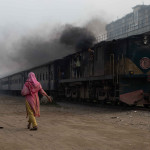
Home | blog
Dhaka’s Desperate Struggle for Clean Air
Dhaka’s Desperate Struggle for Clean Air
Published: 25 May 2024 | Updated: 6 February 2025
Dhaka has earned the unenviable title of hosting some of the most hazardous air quality on Earth. With an Air Quality Index (AQI) of 236 and PM2.5 concentrations measured at 32 times above the World Health Organization's (WHO) recommended limits, the city’s atmosphere is not merely polluted—it is toxic, masked under the illusion of urban development. Despite the gravity of this environmental and public health emergency, public response remains disturbingly muted, as if the smog itself has dulled the collective will to act.
This crisis is not new. Dhaka’s air quality has deteriorated over decades, driven by unregulated industrial growth, chaotic urban expansion, and chronic institutional neglect of environmental and health concerns. What is most disturbing is not just the data, but the persistent inertia and lack of effective response from authorities.
Among the leading culprits are the brick kilns that encircle the city—often referred to as the silent killers of Dhaka’s air. These kilns operate day and night, emitting vast amounts of smoke and contributing nearly 58% of the city's particulate matter. While the government has long mandated the transition to cleaner technologies such as zigzag kilns, implementation has been weak and inconsistent. Bangladesh can no longer afford incremental or symbolic actions. A bold policy shift is urgently needed—such as shutting down all illegal kilns within six months, offering financial incentives for cleaner upgrades, and enforcing strict penalties for non-compliance. The success of similar efforts in India proves that such transitions are possible and effective when backed by political will.
Vehicular emissions present another major challenge. The streets of Dhaka are congested with aging, poorly maintained vehicles—many of them diesel-powered—releasing dense, black fumes. In contrast, cities like Singapore have tackled similar issues through a combination of strict emission regulations, congestion pricing, and public transport subsidies. A national policy that accelerates the adoption of electric vehicles while systematically phasing out polluting ones is not aspirational—it is essential. Clean air is a basic right, not a policy option.
Construction dust further compounds the problem. At almost every construction site in Dhaka, one finds open debris, lack of dust suppression measures, and no regulatory enforcement. Unlike cities such as Tokyo, which have strict site management practices—including mandatory barriers, water sprays, and penalties for violations—Dhaka’s construction sector operates with impunity. This must change. The health of millions cannot be sacrificed for infrastructure growth devoid of environmental safeguards.
This is not merely a matter of environmental degradation—it is a deepening public health catastrophe. Long-term exposure to Dhaka’s air is causing a surge in respiratory illnesses, cardiovascular diseases, and developmental disorders in children. The challenge is immense, but the path forward is clear. Strong regulatory enforcement, cross-sector coordination, and urgent policy reform can still turn the tide. The question is: how much longer will we wait to act?


